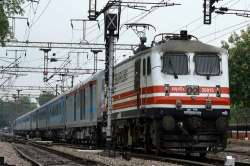Railway Ministry allows train drivers to hit top permissible speed to make up for lost time
The new directive will replace the previously issued order in 2000, as per which trains were supposed to run at maximum permissible speed (MPS) even when they are on time, subject to speed restrictions.

Instead of trying to speed throughout the journey, the Railway Ministry has allowed train drivers to hit the top permissible speed to make up for the lost time in case of trains running late, said a top source in the ministry. As per the earlier order issued in 2000, trains were supposed to run at maximum permissible speed (MPS) even when they are on time, subject to speed restrictions.
The decision came after it was noticed that punctuality of trains suffered as the loco drivers were wary of driving at MPS due to the fear of being caught over speeding, which is punishable, the source said.
Trains having an MPS of 110 kmph will be showed having a normal prescribed speed (booked speed) of 105 kmph and those with 120 kmph MPS will have 115 kmph, as per the new time table slated to be released on August 15.
With 30 per cent trains running late this year, the Railways has now decided to ask drivers to run at the booked speed, the source said.
Drivers can speed up to the maximum permissible speed when they are running late, he added.
"While we want our trains to run at their maximum limit, drivers have the tendency to run them much slower so as to not get penalised for overspeeding, which is going over the MPS," a serving loco pilot said.
"Now, with the limit set at a lower speed, drivers can normally drive at 105 kmph and have the cushion to push the speed upwards to the MPS just enough to gain lost time. The order also means we do not have the pressure of running at MPS all the time,” the driver explained.
As per the new time table, perennially late running trains such as the Raigarh-Gondia Jan Shatabdi Express, the Durg-Ambikapur Express will have a new booked speed, lower than the MPS, but will gain punctuality.
The MPS of mail and express trains is 110 kmph, but they maintain an average speed of 40 to 50 kmph.
Elite class trains such as the Rajdhani and the Shatabdi, having an MPS of 130 kmph, run at an average speed of 80 to 90 kmph.